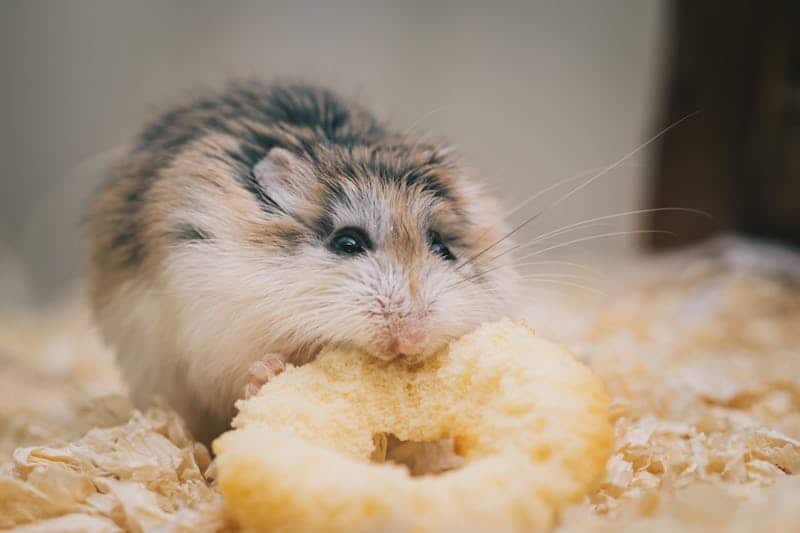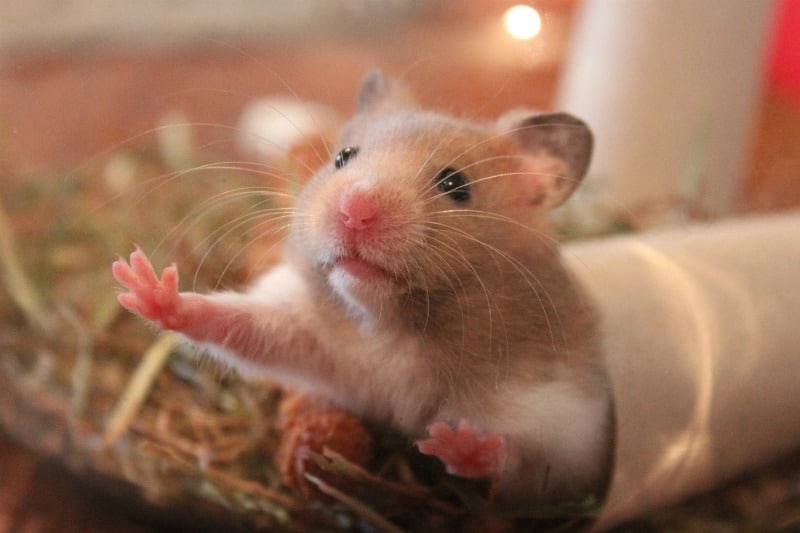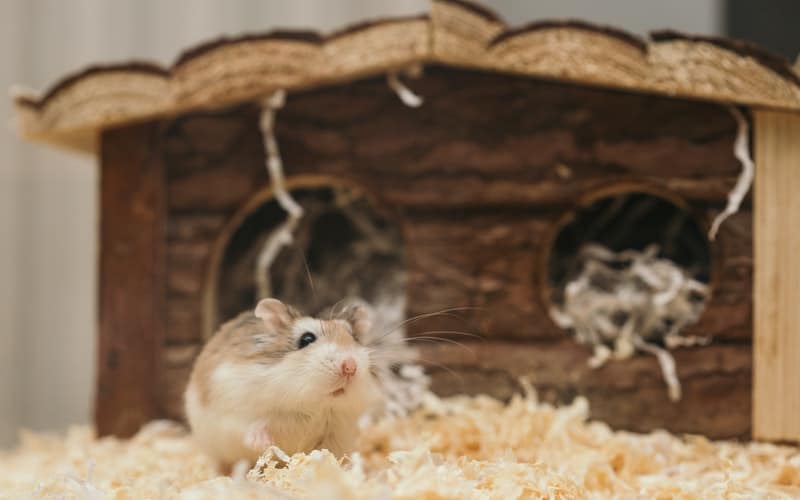Last Updated on April 8, 2024 by ellen
Curious about keeping your hamster cage fresh? Check out these simple tips to keep your hamsters bedding from smelling.
Posts may be sponsored. This post contains affiliate links, which means I will make a commission at no extra cost to you should you click through and make a purchase. As an Amazon Associate I earn from qualifying purchases.
Table of Contents
How to Keep Your Hamster Cage Fresh
Hamsters are delightful little creatures, beloved for their active nature and adorably fuzzy appearance. Despite their small size, they can produce quite a lot of mess, and a clean home is essential to their health and well-being.
In this comprehensive guide, we’ll walk you through the steps to maintain a fresh environment for your hamster, from the best bedding choices to a weekly cleaning routine.
This is one of my favorite hamster cages.
Choosing the Right Bedding
Bedding is crucial for your hamster’s cage, not only for comfort but also for controlling odors. A good bedding will absorb moisture and mask any unwanted smells, keeping your hamster’s home smelling fresh. Here are some popular options:
Aspen Shavings
One of the safest choices is aspen shavings, which are non-toxic and have natural odor-control properties. They also have a lower dust content than other wood shavings. We like this brand.
Paper-Based Products
Recycled paper bedding is a great alternative to wood shavings. It’s dust-free and highly absorbent, making it effective in keeping odors at bay.
Scented Bedding
While it can be tempting to choose scented bedding, it’s best to avoid it. The strong fragrances can be harmful to your hamster’s respiratory system. Instead, opt for baking soda-based bedding, which can be effective at neutralizing odors.
Cleaning the Cage
Regular cleaning is vital for maintaining a fresh cage environment. Here’s a step-by-step guide to cleaning your hamster’s home:
Remove Your Hamster
Ensure your hamster is safely placed in a secure play area. Never clean the cage with your hamster inside, as the chemicals and disturbance can be very stressful.
Disassemble the Cage
Take out all the toys, water bottles, and other accessories. This is also a good time to inspect these items for wear and tear.
Clean the Accessories
Using a mild detergent, scrub the cage accessories with a toothbrush to remove any dirt and bacteria. Rinse them thoroughly and allow them to dry completely before placing them back in the cage.
Don’t forget to remove and clean your hamsters’ toys.
Clean the Cage Itself
For the cage, use a pet-safe disinfectant or a vinegar-water solution to wipe down all surfaces. Pay close attention to corners and crevices where waste may have collected.
Dry and Reassemble
After cleaning, ensure the cage is completely dry before placing fresh bedding and the accessories back in. Dampness can lead to mold and mildew, which is harmful to your hamster.
Waste Removal
Cleaning the cage is an essential part of waste removal, but there are daily and weekly tasks you should also adhere to:
Daily Spot Checks
Each day, quickly scan the cage for soiled bedding and uneaten food. Remove these to prevent the spread of bacteria and odors.
Damp Spots
If you notice any areas of damp bedding, remove and replace it immediately. Damp bedding is a breeding ground for both smell and bacteria.
Sifting the Bedding
Consider using a special cage with a sifting bottom. This will allow you to easily separate clean bedding from waste with minimal fuss, making daily tidying a breeze.
Bonus Tips for a Fresh Hamster Home
To add an extra layer of freshness, consider these additional tips:
Adding an Air Purifier
An air purifier can help keep the air in your hamster’s environment clean and free of allergens and odors.
Incorporating Safe Herbs
Placing pet-safe herbs like parsley, mint, or basil in the cage can naturally freshen the air. Just be sure your hamster doesn’t consume too much of them.
Ensuring Proper Ventilation
Good airflow is crucial in preventing stale air and odors. However, be mindful of drafts and keep the cage in an appropriate location to maintain a consistent, comfortable temperature for your hamster.
By following these guidelines, you can ensure that your hamster’s cage stays fresh and clean. Remember, a healthy and happy hamster needs a clean living space, and the effort you put into maintaining their home will be well worth it as you enjoy your time with your little friend.
Controlling Odors in Your Hamster’s Cage
Controlling odors is a key component in maintaining a healthy and pleasant living environment for your hamster. Here are some effective tips to keep odors at bay:
Choose the Right Bedding
Opt for highly absorbent bedding that’s designed for odor control. Paper-based or aspen shavings are excellent choices, as they naturally suppress smells.
Regular Cleaning Schedule
Adhering to a strict cleaning schedule is crucial. Perform spot cleaning daily, replacing soiled bedding and removing old food. A thorough weekly cleaning can prevent odor build-up.
Provide Adequate Ventilation
Ensure the cage is placed in a well-ventilated area. Good airflow helps to dissipate odors, keeping the cage environment fresh.
Use Natural Odor Absorbers
Natural odor absorbers such as baking soda (in moderate amounts) can be placed near the cage to help neutralize smells. Ensure it’s out of reach of your hamster to avoid ingestion.
Monitor Your Hamster’s Diet
A diet high in fresh fruits and vegetables can contribute to more waste and odor. Moderating these foods in your hamster’s diet can help control the smell.
By following these tips, you can maintain a fresh-smelling hamster cage, contributing to the health and happiness of your furry friend.
Monitoring Your Hamster’s Health Through Cage Hygiene
Maintaining a clean living environment is not only crucial for odor control but also for the overall health of your hamster. A clean cage can prevent the development of respiratory issues and infections, both of which can be common in small pets. Here are some pointers to help you keep an eye on your hamster’s health through cage hygiene:
Observe Changes in Waste
Pay attention to your hamster’s droppings and urine. Sudden changes in consistency, color, or frequency can be early indicators of health issues. Cleanliness allows for easier monitoring and quicker response to potential problems.
Check for Parasites
Regularly cleaning and inspecting the cage and your hamster can help you spot signs of parasites early. Mites and fleas can cause discomfort or even illness in hamsters, so early detection is key to effective treatment.
Prevent Overgrowth of Bacteria
A thorough cleaning routine helps prevent the overgrowth of harmful bacteria that can lead to infections. Ensure that food bowls and water bottles are regularly washed and sanitized, as these can be breeding grounds for bacteria if neglected.
By keeping your hamster’s cage clean and monitoring for any signs of distress or illness, you create a safe and healthy environment for your pet. Regular interaction and observation during cleaning can also strengthen your bond with your hamster, making it easier to notice any unusual behavior or symptoms of illness.

Ellen runs a small pet sitting business in southern Vermont. She has experience with a variety of small animals, dogs and cats. She has also cared for ducks, chickens and rabbits. Combined, she has over 20 years of experience in pet care and pet sitting.




